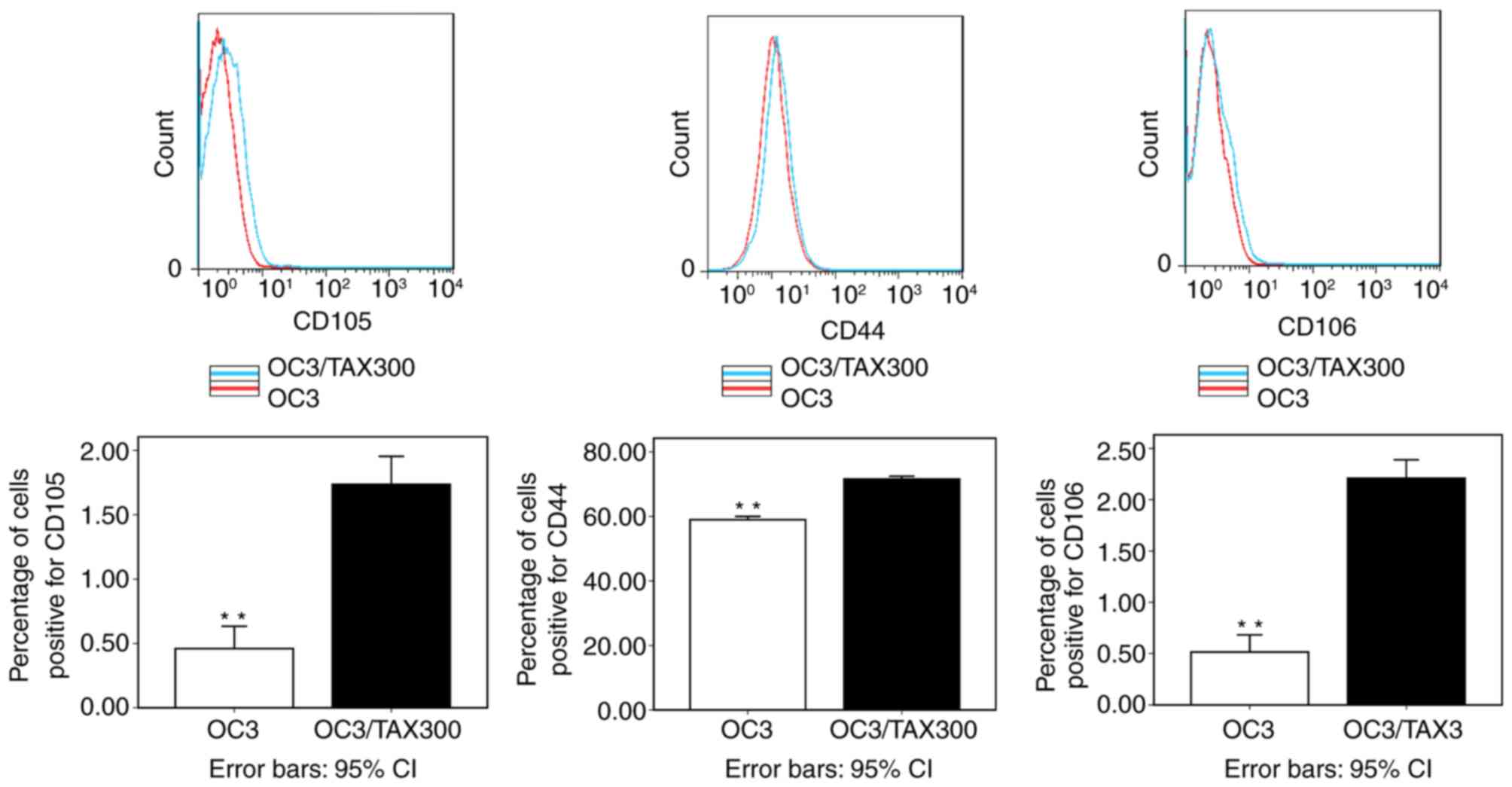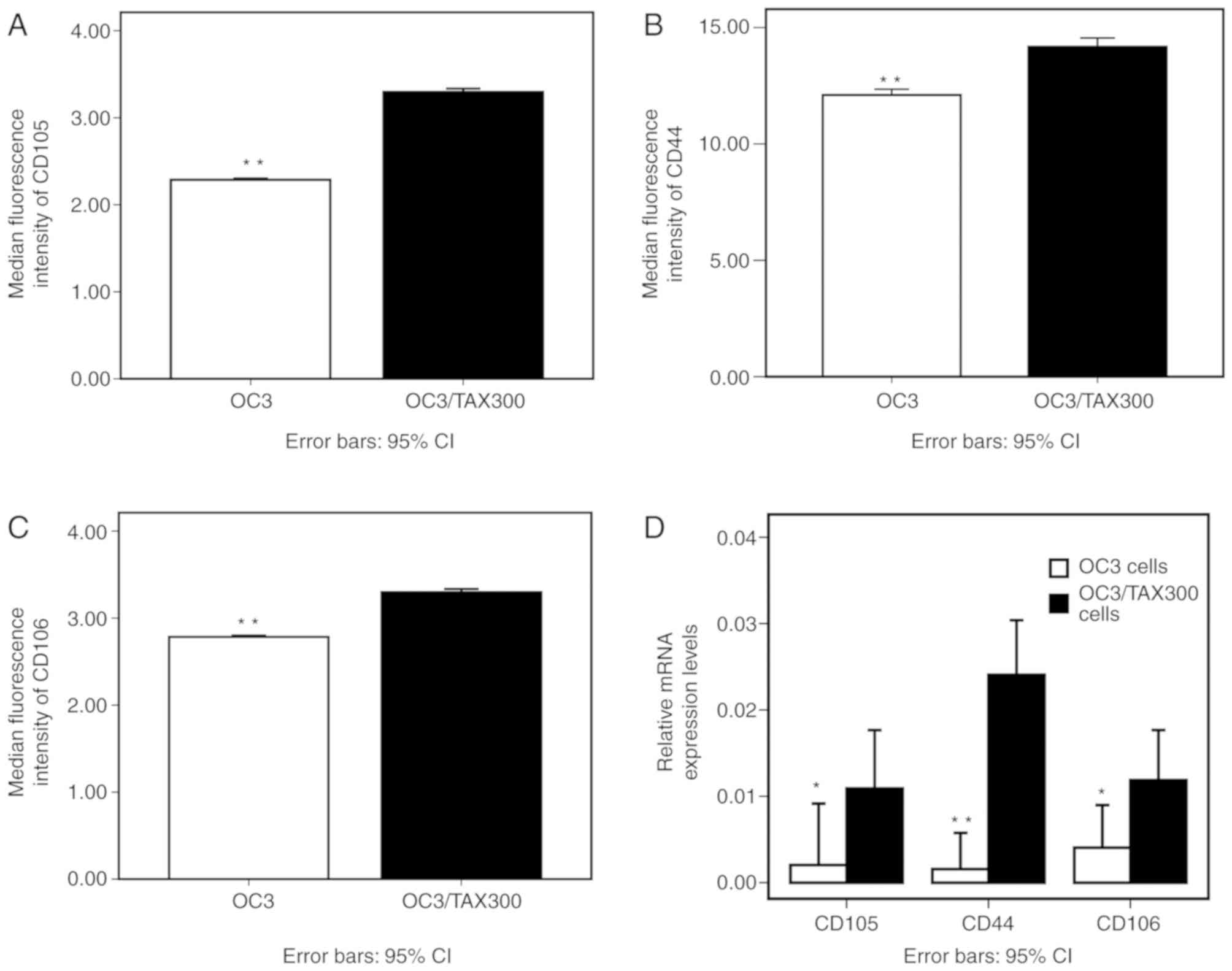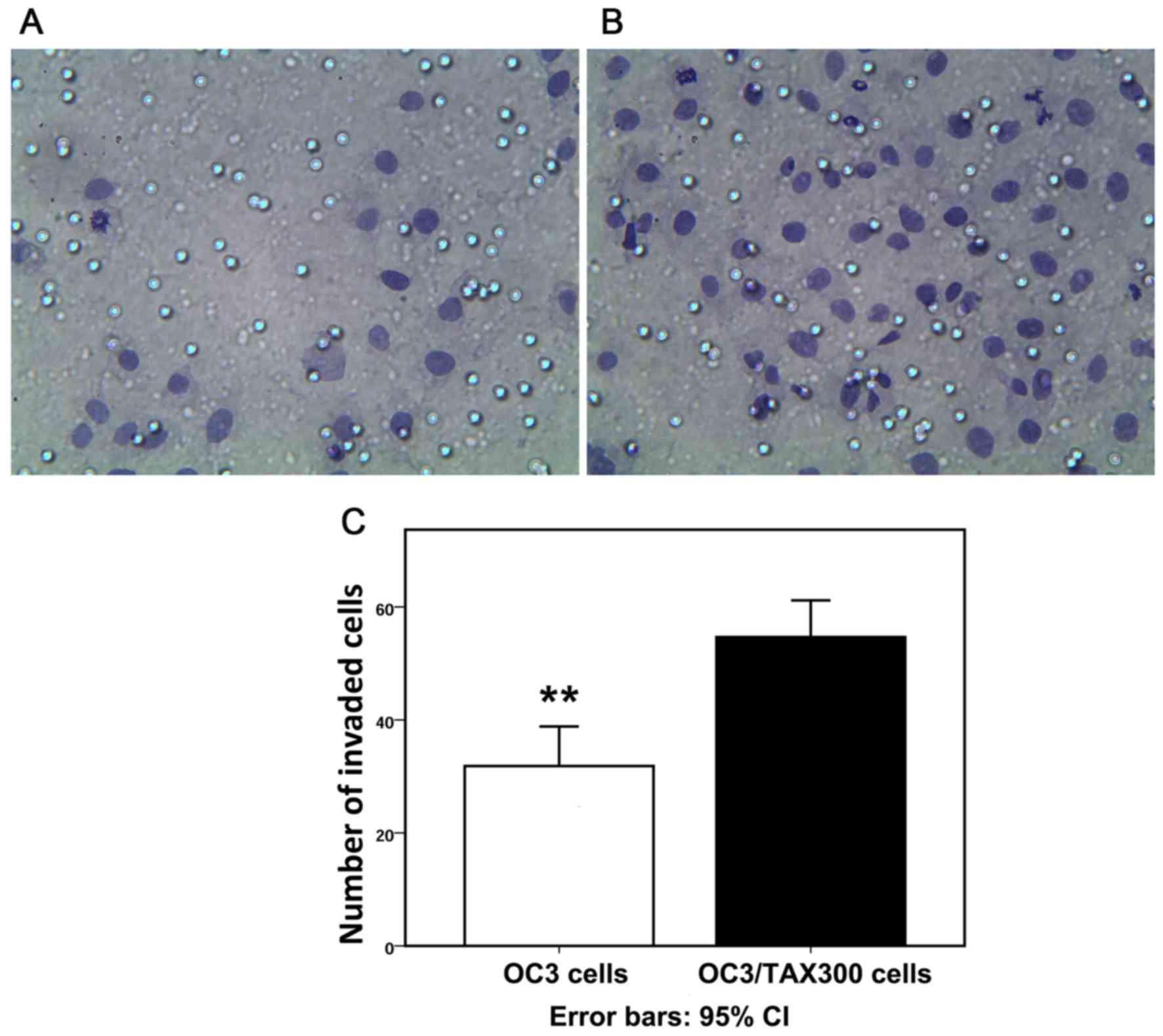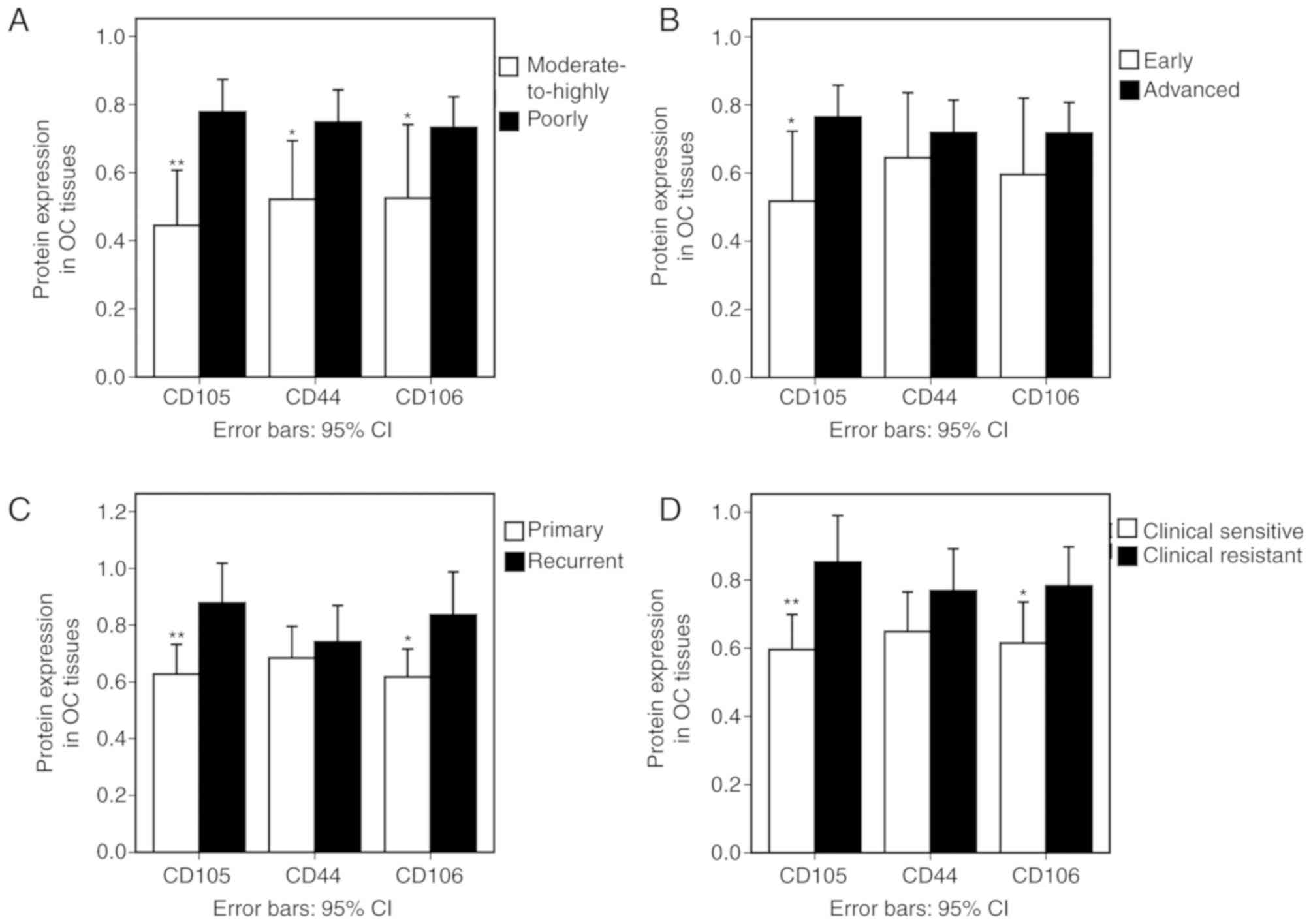|
1
|
Jemal A, Siegel R, Xu J and Ward E: Cancer
statistics, 2010. CA Cancer J Clin. 60:277–300. 2010. View Article : Google Scholar : PubMed/NCBI
|
|
2
|
Steg AD, Bevis KS, Katre AA, Ziebarth A,
Dobbin ZC, Alvarez RD, Zhang K, Conner M and Landen CN: Stem cell
pathways contribute to clinical chemoresistance in ovarian cancer.
Clin Cancer Res. 18:869–881. 2012. View Article : Google Scholar : PubMed/NCBI
|
|
3
|
Rosen JM and Jordan CT: The increasing
complexity of the cancer stem cell paradigm. Science.
324:1670–1673. 2009. View Article : Google Scholar : PubMed/NCBI
|
|
4
|
Dalerba P, Cho RW and Clarke MF: Cancer
stem cells: Models and concepts. Annu Rev Med. 58:267–284. 2007.
View Article : Google Scholar : PubMed/NCBI
|
|
5
|
Hsieh CH, Hsiung SC, Yeh CT, Yen CF, Chou
YW, Lei WY, Pang ST, Chuang CK and Liao SK: Differential expression
of CD44 and CD24 markers discriminates the epithelioid from the
fibroblastoid subset in a sarcomatoid renal carcinoma cell line:
Evidence suggesting the existence of cancer stem cells in both
subsets as studied with sorted cells. Oncotarget. 8:15593–15609.
2017. View Article : Google Scholar : PubMed/NCBI
|
|
6
|
Zhang XF, Weng DS, Pan K, Zhou ZQ, Pan QZ,
Zhao JJ, Tang Y, Jiang SS, Chen CL, Li YQ, et al:
Dendritic-cell-based immunotherapy evokes potent anti-tumor immune
responses in CD105+ human renal cancer stem cells. Mol Carcinog.
56:2499–2511. 2017. View
Article : Google Scholar : PubMed/NCBI
|
|
7
|
Zhang J and Li H: Heterogeneity of tumor
chemosensitivity in ovarian epithelial cancer revealed using the
adenosine triphosphate-tumor chemosensitivity assay. Oncol Lett.
9:2374–2380. 2015. View Article : Google Scholar : PubMed/NCBI
|
|
8
|
Muinao T, Deka Boruah HP and Pal M:
Diagnostic and prognostic biomarkers in ovarian cancer and the
potential roles of cancer stem cells-An updated review. Exp Cell
Res. 362:1–10. 2018. View Article : Google Scholar : PubMed/NCBI
|
|
9
|
Alvero AB, Montagna MK, Holmberg JC,
Craveiro V, Brown DA and Mor G: Targeting the mitochondria
activates two independent cell death pathways in the ovarian cancer
stem cells. Mol Cancer Ther. 10:1385–1393. 2011. View Article : Google Scholar : PubMed/NCBI
|
|
10
|
Slomiany MG, Dai L, Tolliver LB, Grass GD,
Zeng Y and Toole BP: Inhibition of functional hyaluronan-CD44
interactions in CD133-positive primary human ovarian carcinoma
cells by small hyaluronan oligosaccharides. Clin Cancer Res.
15:7593–7601. 2009. View Article : Google Scholar : PubMed/NCBI
|
|
11
|
Bartakova A, Michalova K, Presl J, Vlasak
P, Kostun J and Bouda J: CD44 as a cancer stem cell marker and its
prognostic value in patients with ovarian carcinoma. J Obstet
Gynaecol. 38:110–114. 2018. View Article : Google Scholar : PubMed/NCBI
|
|
12
|
Ho CM, Chang SF, Hsiao CC, Chien TY and
Shih DT: Isolation and characterization of stromal progenitor cells
from ascites of patients with epithelial ovarian adenocarcinoma. J
Biomed Sci. 19:232012. View Article : Google Scholar : PubMed/NCBI
|
|
13
|
Bussolati B, Bruno S, Grange C, Ferrando U
and Camussi G: Identification of a tumor-initiating stem cell
population in human renal carcinomas. FASEB J. 22:3696–3705. 2008.
View Article : Google Scholar : PubMed/NCBI
|
|
14
|
Yang ZX, Han ZB, Ji YR, Wang YW, Liang L,
Chi Y, Yang SG, Li LN, Luo WF, Li JP, et al: CD106 identifies a
subpopulation of mesenchymal stem cells with unique
immunomodulatory properties. PLoS One. 8:e593542013. View Article : Google Scholar : PubMed/NCBI
|
|
15
|
Kokovay E, Wang Y, Kusek G, Wurster R,
Lederman P, Lowry N, Shen Q and Temple S: VCAM1 is essential to
maintain the structure of the SVZ niche and acts as an
environmental sensor to regulate SVZ lineage progression. Cell Stem
Cell. 11:220–230. 2012. View Article : Google Scholar : PubMed/NCBI
|
|
16
|
Huang J, Zhang J, Li H, Lu Z, Shan W,
Mercado-Uribe I and Liu J: VCAM1 expression correlated with
tumorigenesis and poor prognosis in high grade serous ovarian
cancer. Am J Transl Res. 5:336–346. 2013.PubMed/NCBI
|
|
17
|
Zhang J, Zhao J, Zhang W, Liu G, Yin D, Li
J, Zhang S and Li H: Establishment of paclitaxel-resistant cell
line and the underlying mechanism on drug resistance. Int J Gynecol
Cancer. 22:1450–1456. 2012.PubMed/NCBI
|
|
18
|
Zhang L, Liu P, Li H and Xue F: Effect of
histone deacetylase inhibitors on cell apoptosis and expression of
the tumor suppressor genes RUNX3 and ARHI in ovarian tumors. Mol
Med Rep. 7:1705–1709. 2013. View Article : Google Scholar : PubMed/NCBI
|
|
19
|
Zhang J, Yin D and Li H: hMSH2 expression
is associated with paclitaxel resistance in ovarian carcinoma, and
inhibition of hMSH2 expression in vitro restores paclitaxel
sensitivity. Oncol Rep. 32:2199–2206. 2014. View Article : Google Scholar : PubMed/NCBI
|
|
20
|
Benson DA, Cavanaugh M, Clark K,
Karsch-Mizrachi I, Lipman DJ, Ostell J and Sayers EW: GenBank.
Nucleic Acids Res 41 (Database Issue). D36–D42. 2013.
|
|
21
|
Livak KJ and Schmittgen TD: Analysis of
relative gene expression data using real-time quantitative PCR and
the 2(-Delta Delta C(T)) method. Methods. 25:402–408. 2001.
View Article : Google Scholar : PubMed/NCBI
|
|
22
|
Daly MB, Pilarski R, Berry M, Buys SS,
Farmer M, Friedman S, Garber JE, Kauff ND, Khan S, Klein C, et al:
NCCN Guidelines insights. Genetic/Familial High-risk assessment:
Breast and ovarian. version 2.2017. J Natl Compr Canc Netw.
15:9–20. 2017. View Article : Google Scholar : PubMed/NCBI
|
|
23
|
Ozga M, Aghajanian C, Myers-Virtue S,
McDonnell G, Jhanwar S, Hichenberg S and Sulimanoff I: A systematic
review of ovarian cancer and fear of recurrence. Palliat Support
Care. 13:1771–1780. 2015. View Article : Google Scholar : PubMed/NCBI
|
|
24
|
Fung-Kee-Fung M, Oliver T, Elit L, Oza A,
Hirte HW and Bryson P: Optimal chemotherapy treatment for women
with recurrent ovarian cancer. Curr Oncol. 14:195–208. 2007.
View Article : Google Scholar : PubMed/NCBI
|
|
25
|
Barbara NP, Wrana JL and Letarte M:
Endoglin is an accessory protein that interacts with the signaling
receptor complex of multiple members of the transforming growth
factor-beta superfamily. J Biol Chem. 274:584–594. 1999. View Article : Google Scholar : PubMed/NCBI
|
|
26
|
Nassiri F, Cusimano MD, Scheithauer BW,
Rotondo F, Fazio A, Yousef GM, Syro LV, Kovacs K and Lloyd RV:
Endoglin (CD105): A review of its role in angiogenesis and tumor
diagnosis, progression and therapy. Anticancer Res. 31:2283–2290.
2011.PubMed/NCBI
|
|
27
|
Dallas NA, Samuel S, Xia L, Fan F, Gray
MJ, Lim SJ and Ellis LM: Endoglin (CD105): A marker of tumor
vasculature and potential target for therapy. Clin Cancer Res.
14:1931–1937. 2008. View Article : Google Scholar : PubMed/NCBI
|
|
28
|
Taskiran C, Erdem O, Onan A, Arisoy O,
Acar A, Vural C, Erdem M, Ataoglu O and Guner H: The prognostic
value of endoglin (CD105) expression in ovarian carcinoma. Int J
Gynecol Cancer. 16:1789–1793. 2006. View Article : Google Scholar : PubMed/NCBI
|
|
29
|
Saad RS, El-Gohary Y, Memari E, Liu YL and
Silverman JF: Endoglin (CD105) and vascular endothelial growth
factor as prognostic markers in esophageal adenocarcinoma. Hum
Pathol. 36:955–961. 2005. View Article : Google Scholar : PubMed/NCBI
|
|
30
|
Chien CY, Su CY, Hwang CF, Chuang HC, Chen
CM and Huang CC: High expressions of CD105 and VEGF in early oral
cancer predict potential cervical metastasis. J Surg Oncol.
94:413–417. 2006. View Article : Google Scholar : PubMed/NCBI
|
|
31
|
Cho T, Shiozawa E, Urushibara F, Arai N,
Funaki T, Takehara Y, Tazawa S, Misawa M, Homma M, Norose T, et al:
The role of microvessel density, lymph node metastasis, and tumor
size as prognostic factors of distant metastasis in colorectal
cancer. Oncol Lett. 13:4327–4333. 2017. View Article : Google Scholar : PubMed/NCBI
|
|
32
|
Fonsatti E and Maio M: Highlights on
endoglin (CD105): From basic findings towards clinical applications
in human cancer. J Transl Med. 2:182004. View Article : Google Scholar : PubMed/NCBI
|
|
33
|
Ding S, Li C, Lin S, Yang Y, Liu D, Han Y,
Zhang Y, Li L, Zhou L and Kumar S: Comparative evaluation of
microvessel density determined by CD34 or CD105 in benign and
malignant gastric lesions. Hum Pathol. 37:861–866. 2006. View Article : Google Scholar : PubMed/NCBI
|
|
34
|
Gromova P, Rubin BP, Thys A, Cullus P,
Erneux C and Vanderwinden JM: ENDOGLIN/CD105 is expressed in KIT
positive cells in the gut and in gastrointestinal stromal tumors. J
Cell Mol Med. 16:306–317. 2012. View Article : Google Scholar : PubMed/NCBI
|
|
35
|
Ribeiro OD, Canedo NH and Pannain VL:
Immunohistochemical angiogenic biomarkers in hepatocellular
carcinoma and cirrhosis: Correlation with pathological features.
Clinics (Sao Paulo). 71:639–643. 2016. View Article : Google Scholar : PubMed/NCBI
|
|
36
|
Davidson B, Stavnes HT, Førsund M, Berner
A and Staff AC: CD105 (Endoglin) expression in breast carcinoma
effusions is a marker of poor survival. Breast. 19:493–498. 2010.
View Article : Google Scholar : PubMed/NCBI
|
|
37
|
Litwiniuk M, Niemczyk K, Niderla-Bielińska
J, Łukawska-Popieluch I and Grzela T: Soluble endoglin (CD105)
serum level as a potential marker in the management of head and
neck paragangliomas. Ann Otol Rhinol Laryngol. 126:717–721. 2017.
View Article : Google Scholar : PubMed/NCBI
|
|
38
|
Bock AJ, Tuft Stavnes H, Kærn J, Berner A,
Staff AC and Davidson B: Endoglin (CD105) expression in ovarian
serous carcinoma effusions is related to chemotherapy status.
Tumour Biol. 32:589–596. 2011. View Article : Google Scholar : PubMed/NCBI
|
|
39
|
Hu D, Wang X, Mao Y and Zhou L:
Identification of CD105 (endoglin)-positive stem-like cells in
rhabdoid meningioma. J Neurooncol. 106:505–517. 2012. View Article : Google Scholar : PubMed/NCBI
|
|
40
|
Ziebarth AJ, Nowsheen S, Steg AD, Shah MM,
Katre AA, Dobbin ZC, Han HD, Lopez-Berestein G, Sood AK, Conner M,
et al: Endoglin (CD105) contributes to platinum resistance and is a
target for tumor-specific therapy in epithelial ovarian cancer.
Clin Cancer Res. 19:170–182. 2013. View Article : Google Scholar : PubMed/NCBI
|
|
41
|
Nomura Y, Yamashita T, Oishi N, Nio K,
Hayashi T, Yoshida M, Hayashi T, Hashiba T, Asahina Y, Okada H, et
al: De novo emergence of mesenchymal stem-like CD105+ cancer cells
by cytotoxic agents in human hepatocellular carcinoma. Transl
Oncol. 10:184–189. 2017. View Article : Google Scholar : PubMed/NCBI
|
|
42
|
Minhajat R, Mori D, Yamasaki F, Sugita Y,
Satoh T and Tokunaga O: Organ-specific endoglin (CD105) expression
in the angiogenesis of human cancers. Pathol Int. 56:717–723. 2006.
View Article : Google Scholar : PubMed/NCBI
|
|
43
|
Hu J, Guan W, Liu P, Dai J, Tang K, Xiao
H, Qian Y, Sharrow AC, Ye Z, Wu L and Xu H: Endoglin is essential
for the maintenance of self-renewal and chemoresistance in renal
cancer stem cells. Stem Cell Rep. 9:464–477. 2017. View Article : Google Scholar
|
|
44
|
Ehlerding EB, Lacognata S, Jiang D,
Ferreira CA, Goel S, Hernandez R, Jeffery JJ, Theuer CP and Cai W:
Targeting angiogenesis for radioimmunotherapy with a
177Lu-labeled antibody. Eur J Nucl Med Mol Imaging.
45:123–131. 2018. View Article : Google Scholar : PubMed/NCBI
|
|
45
|
Dourado KMC, Baik J, Oliveira VKP,
Beltrame M, Yamamoto A, Theuer CP, Figueiredo CAV, Verneris MR and
Perlingeiro RCR: Endoglin: A novel target for therapeutic
intervention in acute leukemias revealed in xenograft mouse models.
Blood. 129:2526–2536. 2017. View Article : Google Scholar : PubMed/NCBI
|
|
46
|
Duffy AG, Ma C, Ulahannan SV, Rahma OE,
Makarova-Rusher O, Cao L, Yu Y, Kleiner DE, Trepel J, Lee MJ, et
al: Phase I and preliminary phase II study of TRC105 in combination
with sorafenib in hepatocellular carcinoma. Clin Cancer Res.
23:4633–4641. 2017. View Article : Google Scholar : PubMed/NCBI
|
|
47
|
Apolo AB, Karzai FH, Trepel JB, Alarcon S,
Lee S, Lee MJ, Tomita Y, Cao L, Yu Y, Merino MJ, et al: A phase II
clinical trial of TRC105 (anti-endoglin antibody) in adults with
advanced/metastatic urothelial carcinoma. Clin Genitourin Cancer.
15:77–85. 2017. View Article : Google Scholar : PubMed/NCBI
|
|
48
|
Malhotra S and Kincade PW: Canonical Wnt
pathway signaling suppresses VCAM-1 expression by marrow stromal
and hematopoietic cells. Exp Hematol. 37:19–30. 2009. View Article : Google Scholar : PubMed/NCBI
|
|
49
|
Yamada Y, Arao T, Matsumoto K, Gupta V,
Tan W, Fedynyshyn J, Nakajima TE, Shimada Y, Hamaguchi T, Kato K,
et al: Plasma concentrations of VCAM-1 and PAI-1: A predictive
biomarker for post-operative recurrence in colorectal cancer.
Cancer Sci. 101:1886–1890. 2010. View Article : Google Scholar : PubMed/NCBI
|
|
50
|
Yurkovetsky Z, Skates S, Lomakin A, Nolen
B, Pulsipher T, Modugno F, Marks J, Godwin A, Gorelik E, Jacobs I,
et al: Development of a multimarker assay for early detection of
ovarian cancer. J Clin Oncol. 28:2159–2166. 2010. View Article : Google Scholar : PubMed/NCBI
|
|
51
|
Dymicka-Piekarska V, Guzinska-Ustymowicz
K, Kuklinski A and Kemona H: Prognostic significance of adhesion
molecules (sICAM-1, sVCAM-1) and VEGF in colorectal cancer
patients. Thromb Res. 129:e47–e50. 2012. View Article : Google Scholar : PubMed/NCBI
|
|
52
|
Shah N, Cabanillas F, McIntyre B, Feng L,
McLaughlin P, Rodriguez MA, Romaguera J, Younes A, Hagemeister FB,
Kwak L and Fayad L: Prognostic value of serum CD44, intercellular
adhesion molecule-1 and vascular cell adhesion molecule-1 levels in
patients with indolent non-Hodgkin lymphomas. Leuk Lymphoma.
53:50–56. 2012. View Article : Google Scholar : PubMed/NCBI
|
|
53
|
Ding YB, Chen GY, Xia JG, Zang XW, Yang HY
and Yang L: Association of VCAM-1 overexpression with oncogenesis,
tumor angiogenesis and metastasis of gastric carcinoma. World J
Gastroenterol. 9:1409–1414. 2003. View Article : Google Scholar : PubMed/NCBI
|
|
54
|
Slack-Davis JK, Atkins KA, Harrer C,
Hershey ED and Conaway M: Vascular cell adhesion molecule-1 is a
regulator of ovarian cancer peritoneal metastasis. Cancer Res.
69:1469–1476. 2009. View Article : Google Scholar : PubMed/NCBI
|
|
55
|
Wang PC, Weng CC, Hou YS, Jian SF, Fang
KT, Hou MF and Cheng KH: Activation of VCAM-1 and its associated
molecule CD44 leads to increased malignant potential of breast
cancer cells. Int J Mol Sci. 15:3560–3579. 2014. View Article : Google Scholar : PubMed/NCBI
|
|
56
|
Chen Q, Zhang XH and Massagué J:
Macrophage binding to receptor VCAM-1 transmits survival signals in
breast cancer cells that invade the lungs. Cancer Cell. 20:538–549.
2011. View Article : Google Scholar : PubMed/NCBI
|
|
57
|
Kim MR, Jang JH, Park CS, Kim TK, Kim YJ,
Chung J, Shim H, Nam IH, Han J and Lee S: A human antibody that
binds to the sixth Ig-like domain of VCAM-1 blocks lung cancer cell
migration in vitro. Int J Mol Sci. 18(pii): E5662017.
View Article : Google Scholar : PubMed/NCBI
|
|
58
|
Yan Y, Zuo X and Wei D: Concise review:
Emerging role of CD44 in cancer stem cells: A Promising biomarker
and therapeutic target. Stem Cells Transl Med. 4:1033–1043. 2015.
View Article : Google Scholar : PubMed/NCBI
|
|
59
|
Takaishi S, Okumura T, Tu S, Wang SS,
Shibata W, Vigneshwaran R, Gordon SA, Shimada Y and Wang TC:
Identification of gastric cancer stem cells using the cell surface
marker CD44. Stem Cells. 27:1006–1020. 2009. View Article : Google Scholar : PubMed/NCBI
|
|
60
|
Hu J, Li G, Zhang P, Zhuang X and Hu G: A
CD44v+ subpopulation of breast cancer stem-like cells
with enhanced lung metastasis capacity. Cell Death Dis.
8:e26792017. View Article : Google Scholar : PubMed/NCBI
|
|
61
|
Pietras A, Katz AM, Ekström EJ, Wee B,
Halliday JJ, Pitter KL, Werbeck JL, Amankulor NM, Huse JT and
Holland EC: Osteopontin-CD44 signaling in the glioma perivascular
niche enhances cancer stem cell phenotypes and promotes aggressive
tumor growth. Cell Stem Cell. 14:357–369. 2014. View Article : Google Scholar : PubMed/NCBI
|
|
62
|
Su YJ, Lai HM, Chang YW, Chen GY and Lee
JL: Direct reprogramming of stem cell properties in colon cancer
cells by CD44. EMBO J. 30:3186–3199. 2011. View Article : Google Scholar : PubMed/NCBI
|
|
63
|
Gao Y, Foster R, Yang X, Feng Y, Shen JK,
Mankin HJ, Hornicek FJ, Amiji MM and Duan Z: Up-regulation of CD44
in the development of metastasis, recurrence and drug resistance of
ovarian cancer. Oncotarget. 6:9313–9326. 2015. View Article : Google Scholar : PubMed/NCBI
|














